

CI484-Learning-Technologies - Behaviorism, Cognitivism, Constructivism & Connectivism. Source: Ireland, T. (2007)BEHAVIORISMAccording to the learning theories propounded by the behaviorists learning is a mechanical process of associating the stimulus with response, which produces a new behavior.
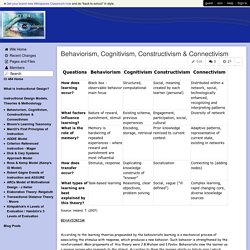
Such behavior is strengthened by the reinforcement. Main proponents of this theory were J.B.Watson and I.Pavlov. Summary of Learning Approaches. In exploring adult learning there are several key factors to consider when thinking about how people learn and the ways in which they make meaning of information and experience.
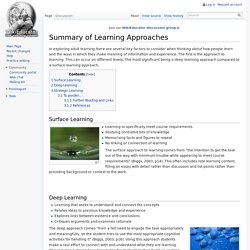
The first is the approach to learning. This can occur on different levels.
Discussion. Theories of learning. Objectives: Consider a variety of theories of learning Identify several principles of learning Understand how individual differences affect the learning process There are many different theories of how people learn.
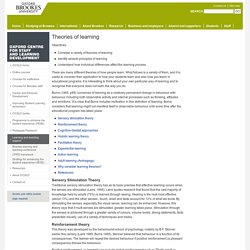
What follows is a variety of them, and it is useful to consider their application to how your students learn and also how you teach in educational programs. It is interesting to think about your own particular way of learning and to recognise that everyone does not learn the way you do. Learning Approaches. Over the years many theories have been developed to examine the processes involved in learning.
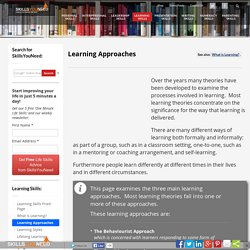
Most learning theories concentrate on the significance for the way that learning is delivered. There are many different ways of learning both formally and informally: as part of a group, such as in a classroom setting, one-to-one, such as in a mentoring or coaching arrangement, and self-learning. Furthermore people learn differently at different times in their lives and in different circumstances.
This page examines the three main learning approaches. Experiential Learning: Just Because It's Hands-On Doesn't Mean It's Minds-On. Experiential Learning: Just Because It’s Hands-On Doesn’t Mean It’s Minds-On by Grant Wiggins, Authentic Education I recently visited Thetford Academy in Vermont (one of the few and interesting public-private academies in New England) where they have a formal and explicit commitment to “experiential learning.”

So, the leaders of the school asked me to visit classes that were doing experiential learning and to talk with staff at day’s end about it. I saw some great examples of such instruction. The Ingredients Of A Creative Teacher - The Ingredients Of A Creative Teacher by Melissa Goodwin, creativist.io There is a lot of talk about creativity these days.

Optimal Learning - The Second Principle. The good news is that students can get better and better provided that we design instruction to improve their skills-and we can do so right from the start, in kindergarten and first grade.”
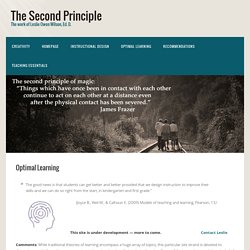
(Joyce B., Weil M., & Calhoun E. (2009) Models of teaching and learning, Pearson, 13) This site is under development — more to come. Contact Leslie Comments: While traditional theories of learning encompass a huge array of topics, this particular site strand is devoted to discussions and information on newer innovations in education that optimize learning. Some of the innovations and views included in this site strand are: newer views of intelligence, holistic learning and teaching, brainbased education (aka educational neuroscience) , as well as suggestions on how to create teaching environments where optimal human learning is supported and nurtured.
Models of Teaching - The Second Principle. An Overview: Exactly what are teaching models and why are they so important to the quality of instruction?

©Leslie Owen Wilson Contact Leslie Simply put models of teaching deal with the ways in which learning environments and instructional experiences can be constructed, sequenced, or delivered. Group dynamics – how group size affects function — E-Learning Modules. It is vital when dealing with any size or composition of group that the teacher is aware of the ways in which groups may interact.

As well as the physical environment and seating arrangements, other factors such as the size of the group influence the group dynamics. The size of the group places limitations on the tasks and functions that it might be expected to perform. Teachers toolbox - document downloads. Manchester Metropolitan University. Edutopia. Although many other methods of teaching are noteworthy -- such as case study, problem-based learning, and simulation -- many scholars agree that students need "careful, personal instruction with clear demonstrations in reading and writing", as well as in social studies, math, and science.
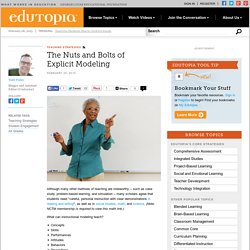
(Note: NCTM membership is required to view this math link.) What can instructional modeling teach? Concepts Skills Performances Attitudes Behaviors Dispositions Thinking.